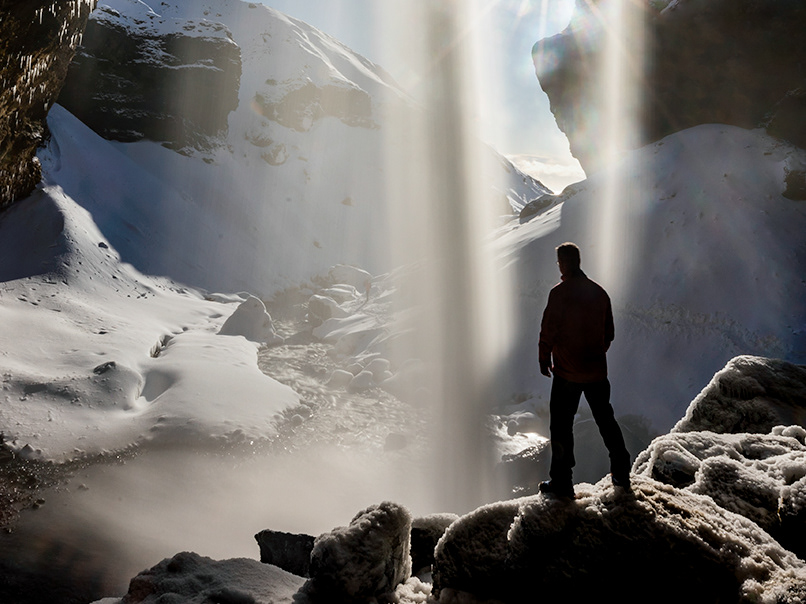Few tips when photographing in Iceland
1. Camera gear
DSRL camera that is good for all kinds of weather, good for landscape, nature and northern lights.
Various lenses; 16-35mm for landscape and norhtern lights, 24-70mm for people and longer lens for landscape and animals, puffins. Its good to have bright lenses.
Protection for you camera and lenses. Rain and drizzle can be an issue here in Iceland. The rain is not always coming straight down, usually its windy at the same time. Bring protection, plastic, rubber and cloth to keep your gear dry and safe.
Steady and sturdy tripod that can stand the wind here in Iceland, you also need to use it in the water. Dont bring cheap and weak tripods to Iceland. The camera might fall and break or get wet in a river.
Filters for waterfalls and waves. Quailty filters like Lee, Nisi and Kase. 3, 6, 10 stoppers, graduate and reverse.
Big cloth to wipe water off your camera/lens when you are close to waterfall and waves on the beach. What works best is a split microfiber towel.
Few memory cards and batteries
Remote control for northern lights
You can also bring a drone and use it where it is allowed. Take off and land far from people and dont fly over them. Dont use it when its windy and raining. Bring 4-5 batteries.
Waterproof acitions cameras can also be interesting for closer shots of waterfalls and waves.
Whenever your camera gear is not in use, keep it in the camera bag. At the end of your shoot, when you move your gear from a cold environment into the warm confines of your car, home or hotel, you risk triggering the cycle of condensation. So as soon as you move inside, take the camera gear out of your bag, remove all the memory cards and batteries, sit it all on a bench and cover it with a towel. The towel should absorb any moisture from your equipment. Let it all come back to room temperature before reassembling and putting it back into the bag.
2. Don’t endanger yourself (or others)
Dont risk your life or someone else when trying to take the million dollar picture. Look out for the weather, check everyday the weather websites and see how the weather and road condtions are going to be - weather changes very quickly here in Iceland. Use your common sense and don’t ignore warning signs. When it’s really windy, don’t venture to close to the edge of a cliff
3. Do some research in advance and take your time shooting
Be prepared in advance, research the location before you come there. Try to be there when the light is good for that location. Make sure you know how to get there, know what else there might be to see at that location and figure out when to be there. Look at what others have photographed there so you know in advance what the possibilities are. Use photoapps like "PhotoPills" to see where the sun is at the right time. Take your time and stay a bit longer at fewer locations to make sure you capture the best possible conditions on that day. In Iceland, the light and weather conditions can change rapidly – which could make that shot you’re trying to take a lot more impressive. Don’t forget that in summer, there’s daylight for almost 24 hours – use that!
During the winter months in Iceland, the sun doesn’t rise very high above the horizon. Rather, it hovers low for a long time, meaning that the light will remain extremely soft, warm and somewhat glowing throughout the day.
4. Try different compostions and exposure
Move around, explore different positions and try out different angles. If you planned your trip by looking at other people’s photographs, make sure you know what compositions have been done a million times and do something different. Use something that could be interesting for the foreground - flower, rock, people for scaling. Think about the rules; rule of third, leading lines, filling the frame, dont have too much negative space - also brake the rules if that is fitting. Be creative, think outside the box.
Try different exposures, specially with waterfalls. You dont always see on your small screen what picture you like the most. Use also different exposure to bracket in the post processing. That can be helpful when you are shoting locations that have great difference in contrast.
5. Photographing waterfalls
We have more than ten thousand waterfalls in Iceland and many of them are very photogenic. There are many possiblities to shoot them; one is to use tripod and filters to slow down the exposure and get silky smooth water, another it to freeze the moment. Either way you like it then is also interesting to have some people in front to get scale , birds flying, rainbow when the sun is shining and a spray coming from the waterfall.
Steady tripod, wide lens for the whole waterfall and zoom lens for details and parts, quility filters 3 or 6 stoppers, try different exposure to see the difference afterwards, people for scaling dressed in colourful jacket.
6. Focus on interesting foreground
When you are coming to an iteresting photo locations, it can be a waterfall, mountain, seascape rocks and more. Always look for something interesting in the foreground, texture, patterns, leading lines, grass tops, flowers, rocks - whatever that can make the picture more interesting.
Get creative... don't be afraid to take your tripod as low as it can go. Take few steps to the left or right - look around. By getting down and low with a wide angel lens, you'll really be able to exaggerate the dimensions of your foreground, bringing interest to something that might otherwise be mundane.
Focus stacking can be an great option when you are shoting something interesting in the foreground, then you have everthing in focus.



